Ayr, South Ayrshire, Scotland, UK 作者: 来源: 发布时间:2021-07-28
I. Population and Area
Continent: Europe
Country: The U.K
State/Province: Scotland
City/Town: Ayr, South Ayrshire
Total Area: 1129 Ayrshire (sq mi)
Population in 2015: 46.5 (thousand)
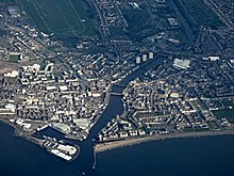
Reference Website:
https://www.google.com.hk/search?newwindow=1&safe=strict&ei=eptkX4r4J9CUmAXCzaDAAQ&q=population+of+Ayr%2C+South+Ayrshire&oq=population+of+Ayr%2C+South+Ayrshire&gs_lcp=CgZwc3ktYWIQA1CKm4oCWIqbigJgvqGKAmgDcAB4AIAB6gKIAbEFkgEDMy0ymAEAoAECoAEBqgEHZ3dzLXdpesABAQ&sclient=psy-ab&ved=0ahUKEwiKnbGrzvLrAhVQCqYKHcImCBgQ4dUDCA0&uact=5
https://www.google.com.hk/search?newwindow=1&safe=strict&ei=dNxmX9DoFYPV9AOY3KWgAQ&q=total+area+of++Ayr&oq=total+area+of++Ayr&gs_lcp=CgZwc3ktYWIQA1DPqQlYz6kJYKytCWgAcAB4AIABvQKIAb0EkgEFMi0xLjGYAQCgAQGqAQdnd3Mtd2l6wAEB&sclient=psy-ab&ved=0ahUKEwjQ8vnK9PbrAhWDKn0KHRhuCRQQ4dUDCA0&uact=5
II. Natural Geography (environment and resources)
Location
Ayr is a coastal town which lies on the mouth of the River Ayr. The river then flows out into the larger Firth of Clyde estuary. From the coast, the Isle of Arran can be seen, and on a very clear day, the northern tip of Northern Ireland. It is within the region of Strathclyde. Much of the land in and around this area is very flat and low lying, used for rearing dairy cattle. Towards the south of Ayr, however, the land is higher than most areas in the county of Ayrshire, an example of this being the Brown Carrick Hill which is situated due south of Doonfoot. Ayr lies approximately 35 miles (55 km) southwest of Glasgow.
The urban area which encompasses Ayr is defined by the General Register Office for Scotland as the adjoining localities of Ayr and Prestwick − this is the 12th largest urban area in Scotland.
Road
Ayr is served by several major roads:
·A77 – forming the Ayr bypass, part of the trunk route between Glasgow and Stranraer. The bypass was built in 1971.
·A79 – the former A77 before the bypass was opened, now the main road running through Ayr and linking Ayr with Prestwick and its airport.
·A70 – running east from Ayr to Cumnock, Lanark and Edinburgh.
·A713 – running southeast to Dalmellington and Castle Douglas.
·A719 – running northeast to Galston and southwest along the coast to Turnberry.
Eight local bus services operated by Stagecoach West Scotland serve Ayr and Prestwick. Express coaches to Glasgow Buchanan Street operate every 30–60 minutes. Ulsterbus operate bus services to Belfast via Stranraer Ferry service on Stena Line.
Rail
The Ayr railway station has regular services to Glasgow Central station, Edinburgh Waverley, Stranraer, Girvan and Kilmarnock. All services are operated by Abellio ScotRail. The railway station provides rail and sea connections via Stranraer for the connecting bus to Cairnryan for either the Stena Line ferry service to the Port of Belfast or the P&O Ferries service to Larne Harbour connecting with Northern Ireland Railways via Carrickfergus and Jordanstown to Belfast Central and Belfast Great Victoria Street. There is also the connection via Troon on P&O Ferries on a seasonal basis to Larne Harbour.
Air
The town is served by the Glasgow Prestwick International Airport just 2 miles (3 km) north from Ayr, which offers regional and domestic air services across Europe and the British Isles. Further destinations are available from Glasgow Airport, which is accessible by train to Paisley Gilmour Street for the connecting bus to the airport. In relation to Ayr, Glasgow Airport is 35 miles (56 km) away.
Ferry
Although the town does not have any ferry services from its harbour, it is in close proximity to ferry services to Northern Ireland. Cairnryan, 60 miles (100 km) south of Ayr, has up to eight daily departures to Belfast and up to seven daily departures to Larne.
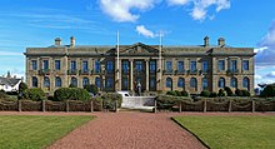
III.Economy
Gross Value Added
While GVA in Scotland grew by 73% in current prices to 2012, growth in South Ayrshire was slower (53%) and weaker still in East and North Ayrshire (22%). Using 2014 prices, GVA has actually fallen over this time in East and North Ayrshire.
GVA and productivity are the core indicators of the health of the economy. GVA represents the value added that is generated for wages and profits, while productivity (measured as GVA per worker) indicates how much added value is created per job. Different industries have the potential to generate different amounts of value for the economy. Higher value added jobs are in engineering, manufacturing, ICT, construction and in professional, scientific and technical activities. Lower GVA per worker sectors are in retail and wholesale, arts and entertainment, accommodation and food and drink services. An economy with more activity in higher value sectors will be wealthier than one that has more activity in lower value added activities.
Table 2-1 shows how GVA has changed over the 15 years to 2012. While GVA in Scotland in current prices has grown by 73%, growth in South Ayrshire has been significantly slower (53%). In East and North Ayrshire growth has been weaker still with just 22% growth in GVA. In real terms (removing inflation) output has actually fallen over the period.
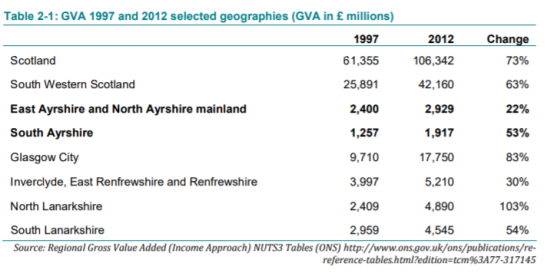
Table 2-1: GVA 1997 and 2012 selected geographies (GVA in £ millions)
1997 2012 Change
Scotland 61,355 106,342 73%
South Western Scotland 25,891 42,160 63%
East Ayrshire and North Ayrshire mainland 2,400 2,929 22%
South Ayrshire 1,257 1,917 53%
Glasgow City 9,710 17,750 83%
Inverclyde, East Renfrewshire and Renfrewshire 3,997 5,210 30%
North Lanarkshire 2,409 4,890 103%
South Lanarkshire 2,959 4,545 54%
Reference Website:
https://www.south-ayrshire.gov.uk/planning/local-development-plans/documents/sqw%20report%20-%20ayrshire%20socio-economic%20profile%20and%20analysis.pdf
IV. Industrial Characterisitics
Major industries:
Coal
The north side of Ayr Harbour still operates as a commercial port, mainly exporting coal, and extensive railway sidings still lead down from the main railway line near Newton-on-Ayr station.
Retail
Ayr developed as the central retail hub in the south-west of Scotland after the opening of the town's first department store, Hourstons, in 1896. In the 1970s the opening of stores such as Marks and Spencers and Ayr's first shopping centre, the Kyle Centre (1988), encouraged an expansion in the local economy. Heathfield Retail park, an out-of-town retail park, opened in 1993 with shops such as Halfords and Homebase. Ayr Central Shopping Centre opened in March 2006, housing shops such as Debenhams and H&M and under-parking for 500 cars. In December 2014 Threesixty Architecture received planning permission to refurbish the Kyle Centre by reinventing it as a centre of leisure through the creation of a new cinema complex among other new features. As of 2014 Royal Society for Public Health found Ayr's High Street to be the second healthiest in the United Kingdom behind Shrewsbury. In 2016 research conducted by the Local Data Company suggested that Ayr had among the highest number of shops per head in the United Kingdom at one shop for every 270 people.
Major projects and related introductions:
Beach Clean
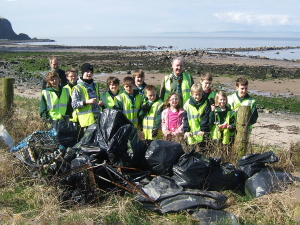
The Rotary Clubs of Girvan, Alloway, Ayr, Prestwick, and Troon hold their Annual Beach Clean – in conjunction with South Ayrshire Council, as part of the Keep Scotland Beautiful campaign. Hundreds of bags full of discarded litter are collected every year. A perfect Rotary project where many volunteers are needed under strong leadership.
Message in a Bottle
The Message in a Bottle initiative is an emergency information scheme that is provided free of charge by the Rotary Clubs of Alloway, Ayr, Girvan, Prestwick and Troon, and the Ayr & Prestwick Lions Club. The scheme is fully supported by the new South Ayrshire Health and Social Care Partnership together with key partners such as the Community Safety Partnership, Police Scotland, Scottish Fire and Rescue, Scottish Ambulance Service and Voluntary Action South Ayrshire.
Reference Website:
https://rotaryclubofayr.org/activities/
V. Attractions
1. The Robert Burns Birthplace Museum:
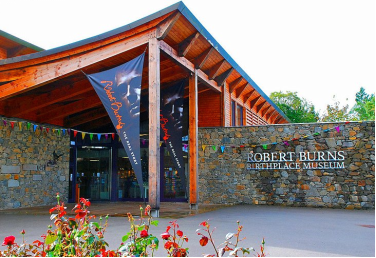
The thatched house where Scotland's most famous poet was born is situated in Alloway, a suburb to the south of Ayr. Built by his father, it was in the Burns Cottage that Robbie Burns spent the first seven years of his life. Now part of the excellent Robert Burns Birthplace Museum, this fascinating tourist attraction houses a collection of Burns' most important writing, along with a great café and shop. For kids, the fun Burns'-themed adventure playground, Scots Wa-Hey, is a must, encouraging a little learning as they play.
2. Culzean Castle and Country Park:
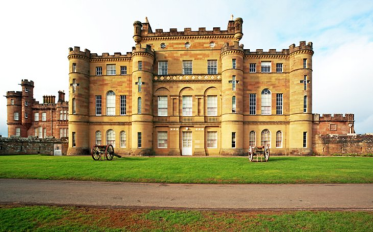
Managed by the National Trust for Scotland, Culzean Castle lies in a picturesque spot on the cliff tops just 12 miles south of Ayr. A fortress had stood on this spot since the 14th century, with the present "picture-book" castle being a creation of the romantic 18th century. Highlights are the Armory, with its extensive collection of pistols, and the old Dining Hall, with its ceiling decorated with paintings by Antonio Zucchi, and Chippendale-style furniture.
3. Dalgarven Mill Museum of Country Life and Costume:
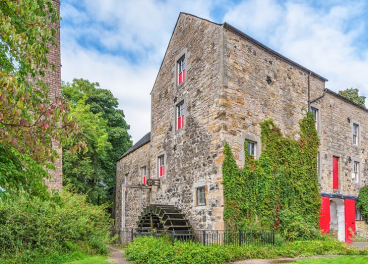
Located in the fully-restored Dalgarven Mill in Kilwinning, the Museum of Ayrshire Country Life and Costume is a treasure trove of facts and artifacts relating to the area's rich cultural history, as well as traditional farming techniques and tools. The centerpiece is the authentic working water wheel, still powered by the River Garnock, and the Victorian machinery it powers, as well as the granaries with displays of costumes and everyday tools and possessions.
Reference Website:
https://www.planetware.com/tourist-attractions-/ayr-sco-stra-ayr.htm
VI. History
Pre-establishment
The areas surrounding modern day Ayr were known to have been occupied by Mesolithic hunter-gathers more than 5,000 years ago. There is also a Neolithic standing stone at the end of Stonefield Park in Doonfoot, which is believed to have been upended as a place of sun worship by Stone Age people.
Establishment and early settlement (1197–1500)
In 1197, King William the Lion ordered that a new castle be built between the River Ayr and the River Doon. It is believed that the castle was a wooden structure built around Montogomerie Terrace. Ayr was later established as a royal burgh and market town on 21 May 1205 by King William the Lion. At its establishment, the burgh encompassed a single street (The Sandgate) and the Church of St John. By 1225 the town reached as far as Carrick Street and Mill Street along the south side of the River Ayr. The town grew quickly to become the main seaport, marketplace and administrative centre for Ayrshire.
Early modern period (1500–1707)
Ayr was continuously hit by a number of plagues from 1545 to 1647, resulting in the town's port being quarantined and plague victims being removed from the town on pain of death. Mary, Queen of Scots visited the town in 1552 and 1563. Ayr remained a significant port throughout the 16th century, exporting goods such as fish, hide and wool and importing salt and wine.
Acts of Union (1707–1914)
The formation of the Kingdom of Great Britain through the Acts of Union 1707 was initially harmful to Ayr, due to the importance to its economy of the wine trade with France. The terms of the English Methuen Treaty of 1703, which favoured the importation of Portuguese and Spanish wines and was accompanied by punitive duties on French wines, were extended to Scotland. However, the Union provided Ayr with significant trading opportunities with Britain's colonies around the world and resulted in improvements to the town's infrastructure, with Ayr's textile, wool, linen and shoemaking industries thriving as a result.
Modern history (1914–)
817 men from Ayr died during the First World War. A memorial was unveiled at Wellington Square in 1924 dedicated to those who died, with other memorials being put up at Alloway Village Hall and Whitletts Cross. Ayr's growing population following the war resulted in significant slum clearance and redevelopment around the town centre, with the development of new housing estates on the periphery of the town. The lands surrounding Woodfield House were acquired by the council in 1919 to build council housing on, with the first residents moving in 1921. In 1929 Ayr was designated as a large burgh and its boundaries were expanded to include Alloway, Castlehill, Doonfoot and Whitletts. In the 1930s, council estates were also developed at Lochside and Heathfield. The mining villages of Dalmilling and Whitletts were also cleared and developed into sizeable council estates. Following the Second World War, more council housing was developed in Ayr at Kincaidston, with the Wallacetown and Whitletts estates being expanded. Suburban housing was also developed at Alloway, Doonfoot and Holmston, and many disused industrial buildings throughout the town were redeveloped into flats.
VII. Culture
Gaiety Theatre
Ayr is home to The Gaiety Theatre. Built in 1902, reconstructed after a fire in 1904, its façade remodelled in 1935, and further reinstated after a fire in 1955. In 1995, an annexe was constructed, including a new café, box office, dressing rooms and studio space. After a faltering start, which saw several years as a cinema after WWI, the theatre was bought by Ben Popplewell, from Bradford, who already had a track record of success running the Pavilion theatre on Ayr seafront. For fifty years the Popplewell family ran the theatre – latterly as part of the Glasgow Pavilion business. During this time the Gaiety developed a reputation as a variety theatre with a 'summer' variety show – the Gaiety Whirl – which ran for 26 weeks at its height. Many British stars appeared regularly on its stage, and several started their careers there. The programme offered more than a summer show, however, with several weeks of Shakespeare and regular transfers from Glasgow Citizens theatre, being part of a varied offer.
Horse racing
Ayr Racecourse is a well-known racecourse in Scotland and hosts both National Hunt and flat racing. It has the largest capacity in Scotland for horse racing. Notable events include the Scottish Grand National (April) and Ayr Gold Cup (September) as well as several night meetings. It was recently put up for sale by the owners and included the Western House Hotel as part of the potential sale.
Football
Ayr has a senior football team, Ayr United F.C., who play at Somerset Park in the Scottish Championship. They reached the final of the 2001–02 Scottish League Cup competition. The club was formed in 1910 with the merger of Ayr F.C. (who were formed in 1879 by the merger of Ayr Thistle and Ayr Academical football clubs) and Ayr Parkhouse F.C..
Ice hockey
The town has a strong history of ice hockey, but no longer hosts a professional ice hockey team. The most recent professional team were the Ayr Scottish Eagles who played in the British Superleague between 1996 and 2002 based at the Centrum arena. During this time they have success most famously their grand slam season in 1997–98 winning all four titles available and becoming British Champions. The following season saw them compete in the European Hockey league with famous victories home and away to Russian champions AK Bars Kazan. Eagles finished 3rd in a group also containing clubs from Germany and Czech Republic. The Centrum closed in 2003 and was demolished in 2009 to make way for a Sainsbury supermarket.
VIII. Other information
The Church of Scotland is the main denomination in Ayr with nine churches spread throughout the town. The Roman Catholic Church has two churches, St Paul's, Belmont and the Cathedral Church of St Margaret the successor to The Good Shepherd Cathedral which has been demolished.
There is also a Free Church of Scotland, a Baptist Church and Evangelical church in John Street, a Latter-Day Saints Church at Orchard Avenue and the Southside Christian Fellowship in Ayr Town Hall. Ayr is also home to two Orange Lodges.
IX. Contact information
Mayor/Officer: Helen Moonie
Tel: 01292 616685
Mail: provost@south-ayrshire.gov.uk
Reference Website:
https://www.south-ayrshire.gov.uk/councillors/provost/provosts-of-ayr.aspx
